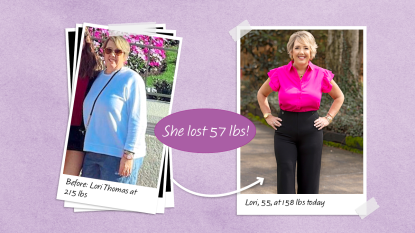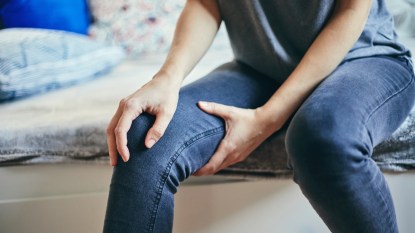How to Beat Joint Pain in 8 Easy Steps

Struggling with stiff, achy joints every day can be miserable and really get in the way of your life, stopping you from doing the things you want to do. Painkillers can help make things more bearable, but there is actually a lot more you can do yourself to manage your pain and keep your joints healthy. In just a few minutes each day, you can change how much your joint pain affects your quality of life so that you can say yes to the things that you love to do.
Happy joints, happy you.
“The secret to healthy joints is to keep them flexible,” says Lyndsay Hirst, Chartered Physiotherapist at Your Pilates Physio. “Your joints are full of synovial fluid which contains all the nutrients they need to stay healthy. But the only way to get these crucial nutrients to every part of your joint is to move them through their full range of movement.”
If your joints hurt this might be the last thing you want to do, but keeping them moving can make a real difference. “Your joints are designed to move, and moving them, even if it’s painful, is what keeps them happy,” says Lyndsay.
But don’t worry, you don’t need to embark on a fancy gym routine. There are some simple tricks that you can work into your daily routine to help keep your joints in great shape.
Your Pain-Busting Plan
1. When you wake up, mobilize your joints.
Morning stiffness is really common and can make it hard to get going. Spending a few minutes moving your joints could help to loosen you up and most importantly will send the synovial fluid whooshing around your joints. “Try to move each joint from head to toe in all directions two or three times,” says Lyndsay. “For example, turn you head from side to side, bend and flex your fingers, rotate your wrists, bend and straighten your knees and arms, lift your knee to your chest, reach your hands above your head and roll your shoulder back.”
Go slowly, waking up your joints until they feel less stiff. If you’re having a flare up of pain, try to move your aching joints in this way a few times every one to two hours to ease discomfort.
2. At breakfast, take an omega-3 supplement.
If there’s one supplement that’s worth taking for joint pain it’s an omega-3 fish oil supplement. Scientists believe that omega-3 fatty acids help to calm inflammation in your joints by stopping your body’s inflammatory response and this, in turn, helps to reduce your pain levels.
Taking fish oil every day could help to make your joints less stiff in the mornings, according to a study in the British Journal of Nutrition. Look for a supplement that contains both EPA and DHA fish oils such as Bioganix ($22.35, Amazon).
3. Take a mid-morning walk.
Another great way to get the synovial fluid to your joints is a daily walk. This could help reduce your risk of osteoarthritis by 18 percent according to scientists, who also suggest that it could help to build cartilage, the layer of tissue that protects the bones in your joints.
Regular walks can help you lose weight too, so you’re putting less pressure on your joints with every step you take. Wear supportive shoes to prevent foot pain.
4. Climb the stairs mid-afternoon.
Stair climbing can be difficult if you have knee or hip pain, but it’s actually one of the best things you can do to improve leg-muscle strength and reduce stress on your joints.
Take it steady and go at your own pace. Hold on to the bannister if you need to. Go up and down for one minute and gradually build up to two minutes. At first you might only be able to manage a few steps, especially if you’re having a joint pain flare up, but over time, as your legs get stronger and support your joints more it should start to become easier.
5. After lunch, build some muscle.
“Keeping muscles strong is really important because it helps support and take the pressure off your joints,” says Lyndsay. “If you struggle with knee pain, try strengthening your thigh muscles. While you’re sitting down lift your foot from the floor to straighten your knee. Hold for 10 seconds and then repeat 10 times on each leg.”
Ease hip pain with slow side leg lifts. Standing next to a table or chair for balance, slowly lift one leg out to the side, pause, then lower to the ground. Repeat 10 times.
6. Before bed, go hot or cold.
If your joints keep you awake at night, reduce swelling and stiffness before bed using either heat or ice. “Use a hot pad or compress for a stiff, aching joint, and an ice-pack for a hot, swollen joint,” says Lyndsay.
7. Soak in a warm bath with magnesium-rich Epsom salts.
The water helps to support your joints and the magnesium is thought to relax your muscles and ease pain.
8. Keep an eye on your weight.
If you are overweight, you are two-and-a-half times more likely to develop osteoarthritis in your knees as excess weight puts additional stress on weight-bearing joints. Not only that, but the inflammatory factors associated with being overweight might contribute to pain in other joints, such as your hands. Maintaining a healthy weight really does have so many benefits!
After a few weeks of following our plan you should notice a real difference to how your joint pain affects you on a daily basis. You do have to be patient and stick with it, which is why it’s a great idea to track how your joints feel and keep a pain diary every day so you can note any changes. Each day give your pain a score out of 10 with “1” being barely noticeable and “10” being debilitating. Taking notice of your improvements will help you stick to your goals each day!
This article originally appeared on our sister site, Yours.
More From Woman’s World
6 Ways to Boost Memory Naturally













